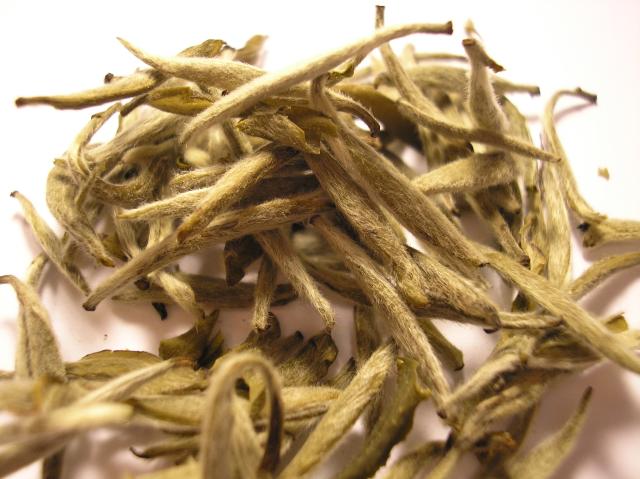
Silver Needle
When it comes to tea, I don't really care what Chinese province it comes from, so long as it's lead and asbestos free and arrives in a neat package at a store that I can buy that's also lead and asbestos free. If you were to ask me, "How is tea made?" you might hear me mumble something about how families strap baskets to their backs and go out into the mountains and start picking tea leaves before the dawning sun's light strikes the tea leaves and buds, ruining its purity and flavor nuances. But of course, that would be a lie. I don't know how tea is grown, gathered, processed and graded, but I DO know how it tastes. My first experience with green tea was the type that came in a Bigelow teabag and tasted like an ashtray (or burnt rubber if you were lucky). Flavor notwithstanding, I realized that it helped me get over colds quickly and didn't make me feel like someone had hooked my muscles up to an electric current. It wasn't until later that I found out that tea's not supposed to taste that way.
Enter the loose leaf tea.
With a few exceptions, loose leaf will be the better quality tea that you buy, no matter where you buy it from. It has the subtleties of flavor that are trapped or obscured by the paper bag that sits between you and the tea in your favorite mug. And unlike tea bags, you can reinfuse the tea leaves about 3 or 4 times depending on the quality of the leaf.
Silver Needle tea is not green tea, but actually white tea. It has a very fragrant, almost sweet taste that's reminiscent of flowers, with an overall delicate taste.
Supposedly this is the highest grade of white tea, and I can see why. It's not cloying, coating, or bitter, but delicately sweet and flowery. After a few cups, your mouth will feel clean, like you've just brushed your teeth.
Enter the loose leaf tea.
With a few exceptions, loose leaf will be the better quality tea that you buy, no matter where you buy it from. It has the subtleties of flavor that are trapped or obscured by the paper bag that sits between you and the tea in your favorite mug. And unlike tea bags, you can reinfuse the tea leaves about 3 or 4 times depending on the quality of the leaf.
Silver Needle tea is not green tea, but actually white tea. It has a very fragrant, almost sweet taste that's reminiscent of flowers, with an overall delicate taste.
Taste
The first taste that greets your tongue is the scent of flowers, and as the tea enters your mouth, you'll notice the sweetness and a slightly fresh, "green" character to the taste that melds together. The finish is light and again, flowery.Scent
The best way to describe the way silver needle smells is to get some essential oil of jasmine, and water it down. It smells a little similar to that. Unlike other teas, this variety is a joy to drink and sniff.Steeping
I've had the best results steeping the first infusion for 5 minutes with a water temperature of about 160 Fahrenheit. The second infusion for about 10 minutes, and the final infusion for about 15 minutes.Supposedly this is the highest grade of white tea, and I can see why. It's not cloying, coating, or bitter, but delicately sweet and flowery. After a few cups, your mouth will feel clean, like you've just brushed your teeth.


No comments:
Post a Comment